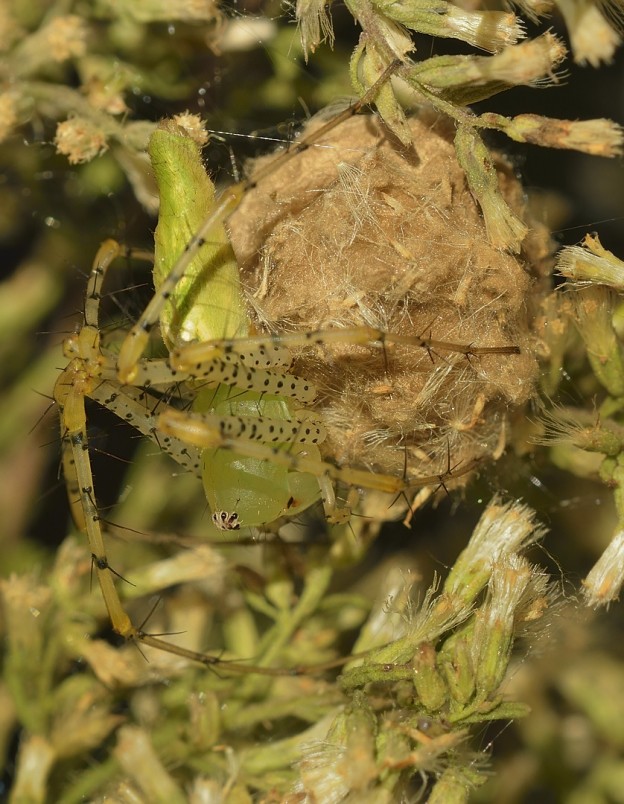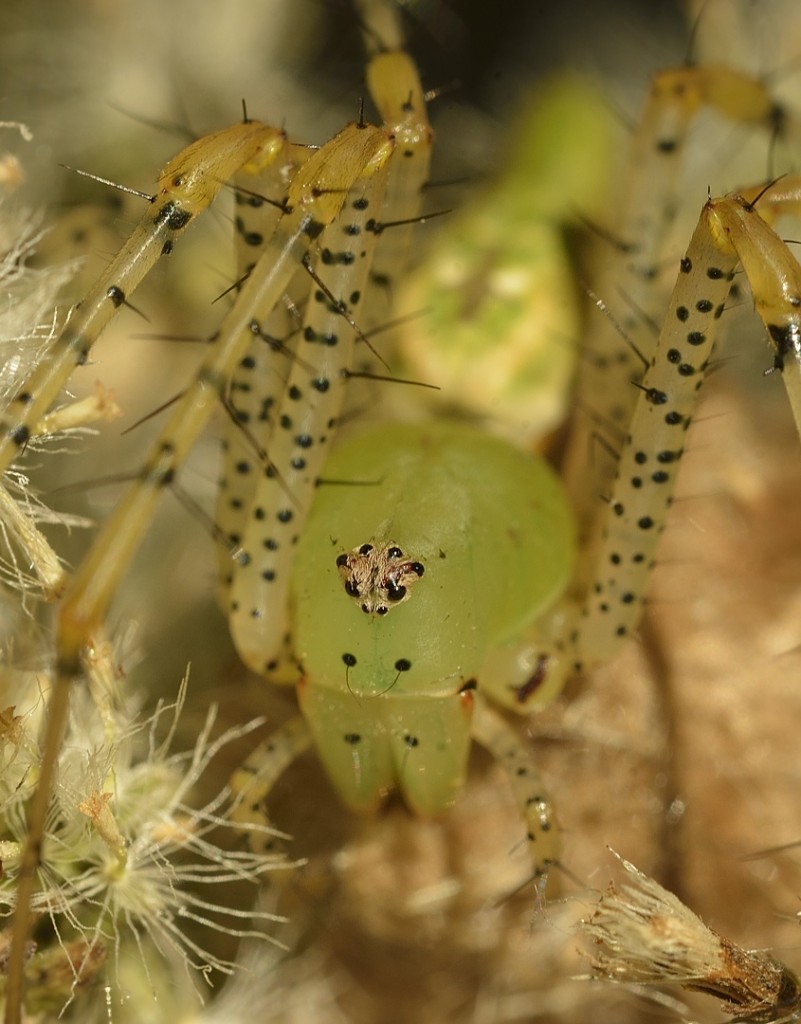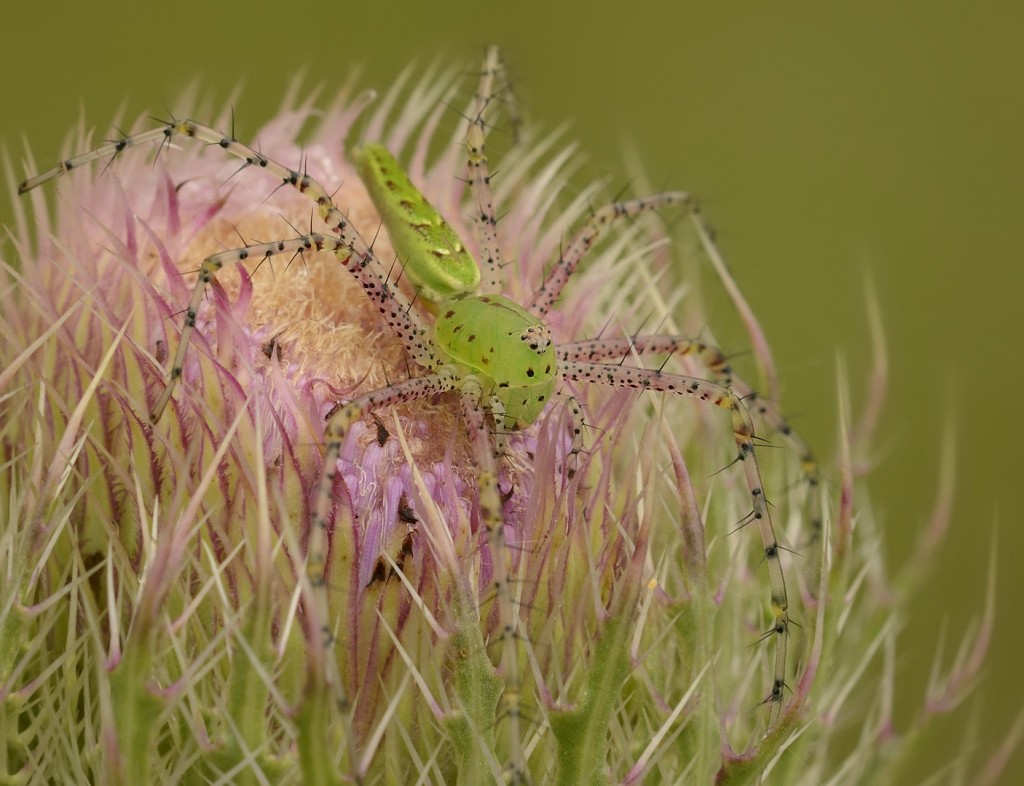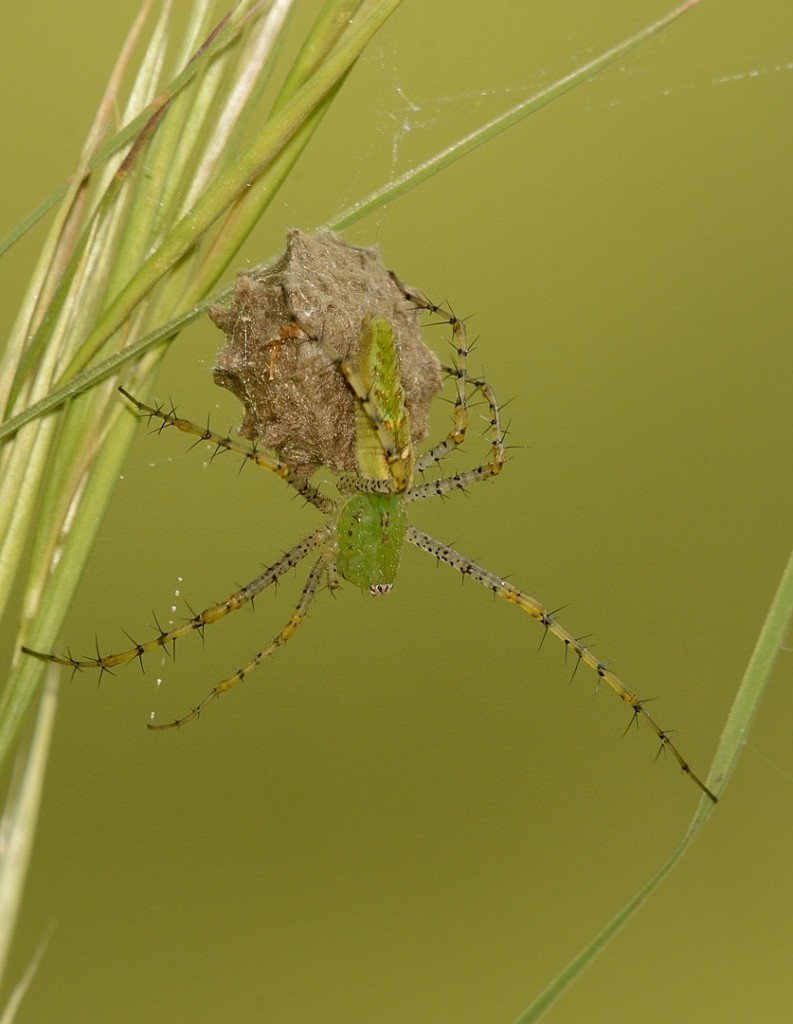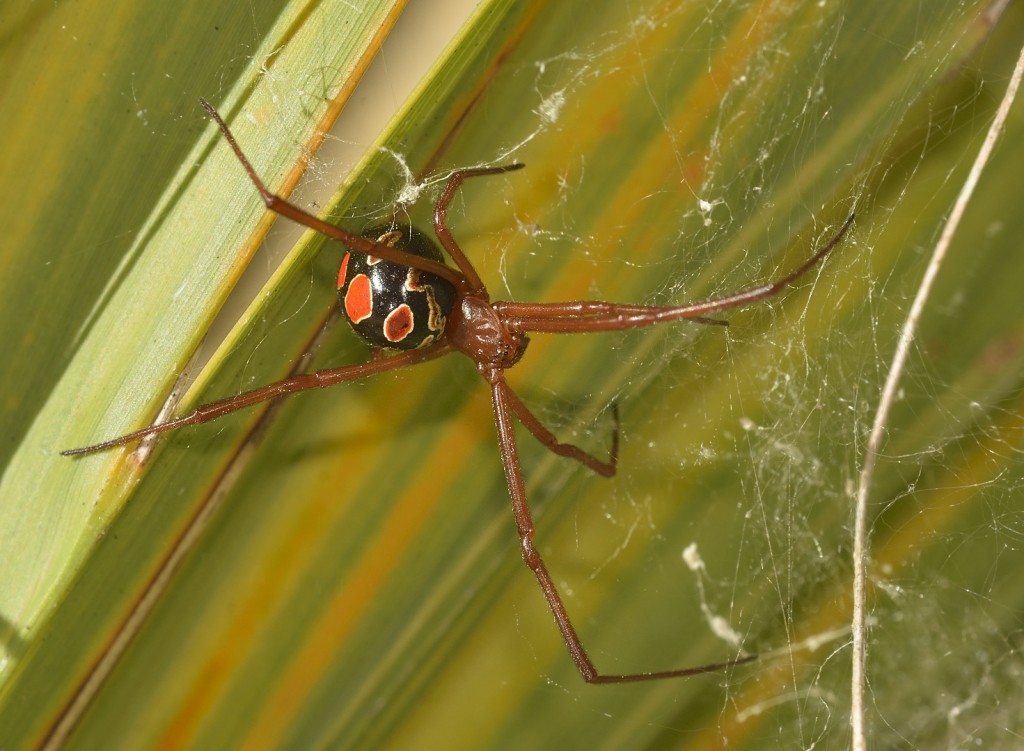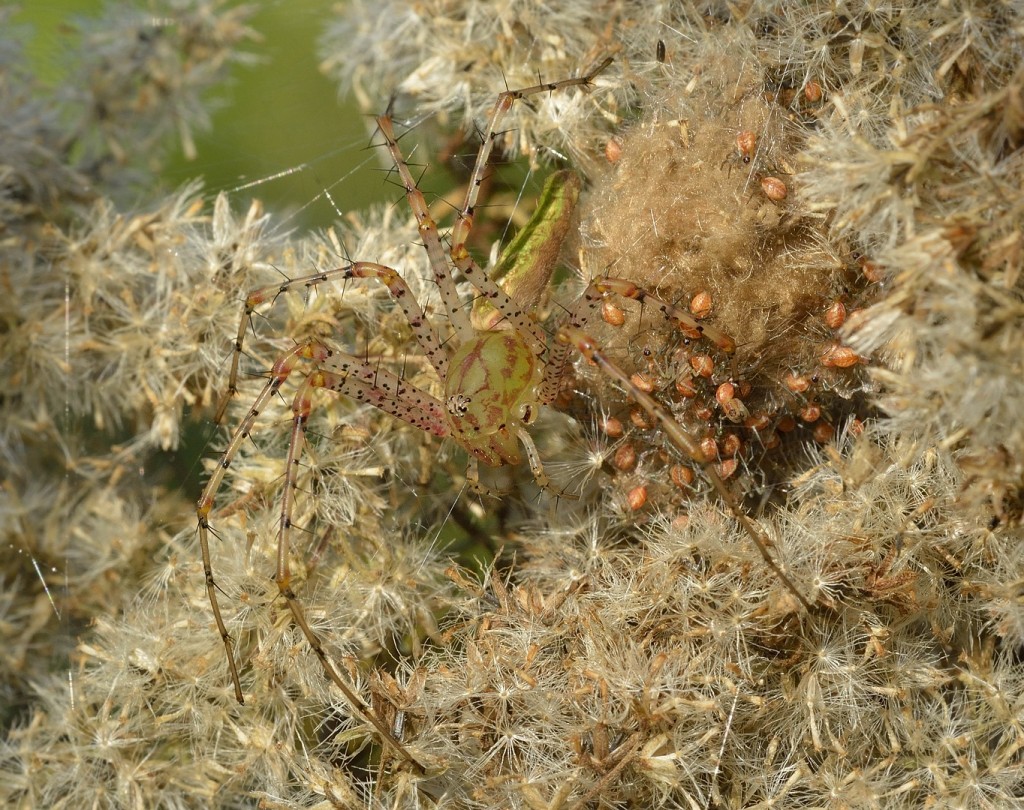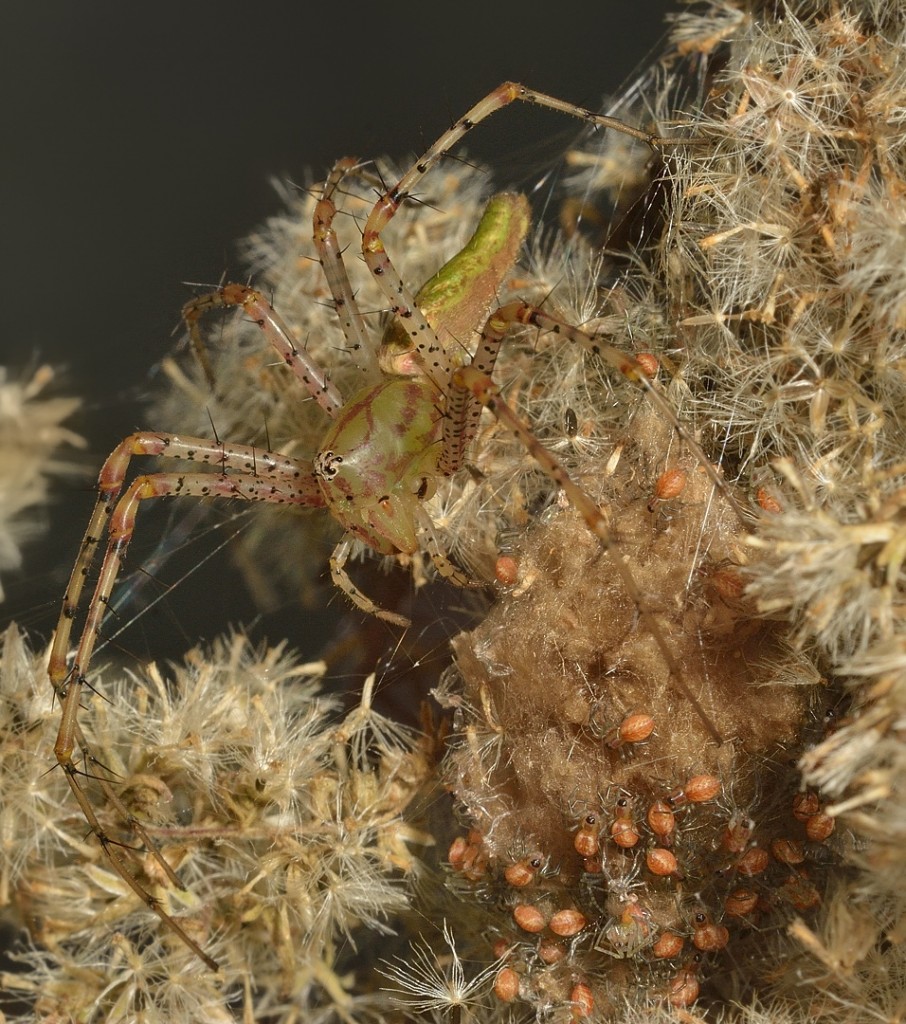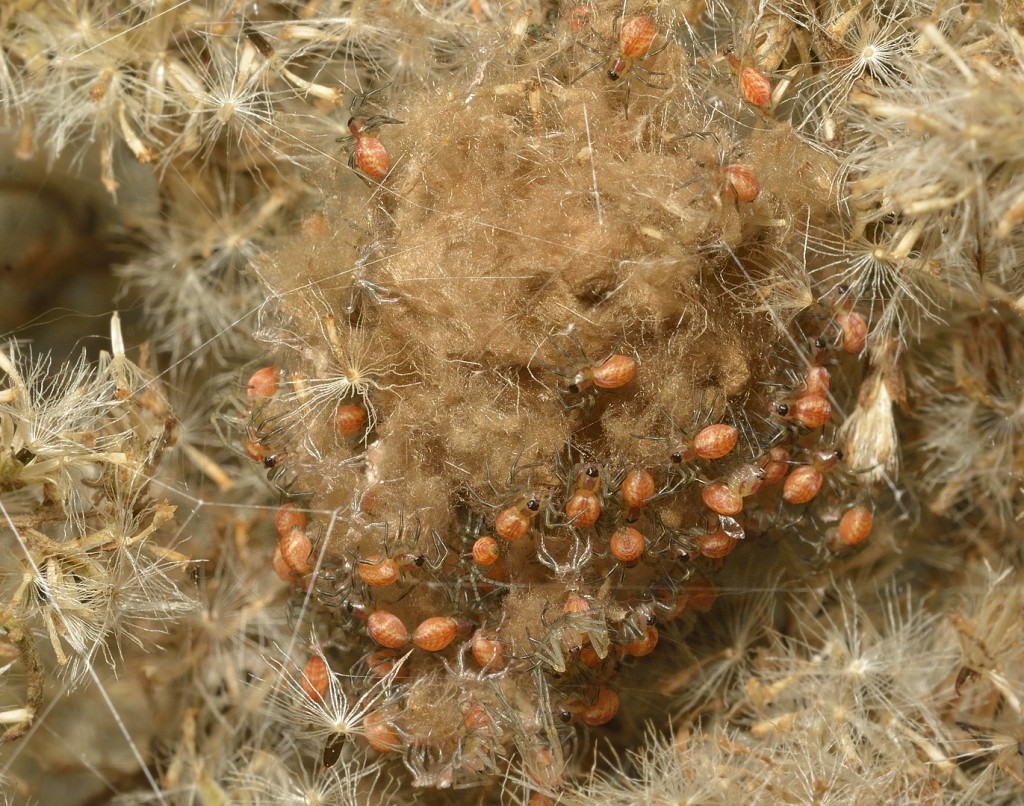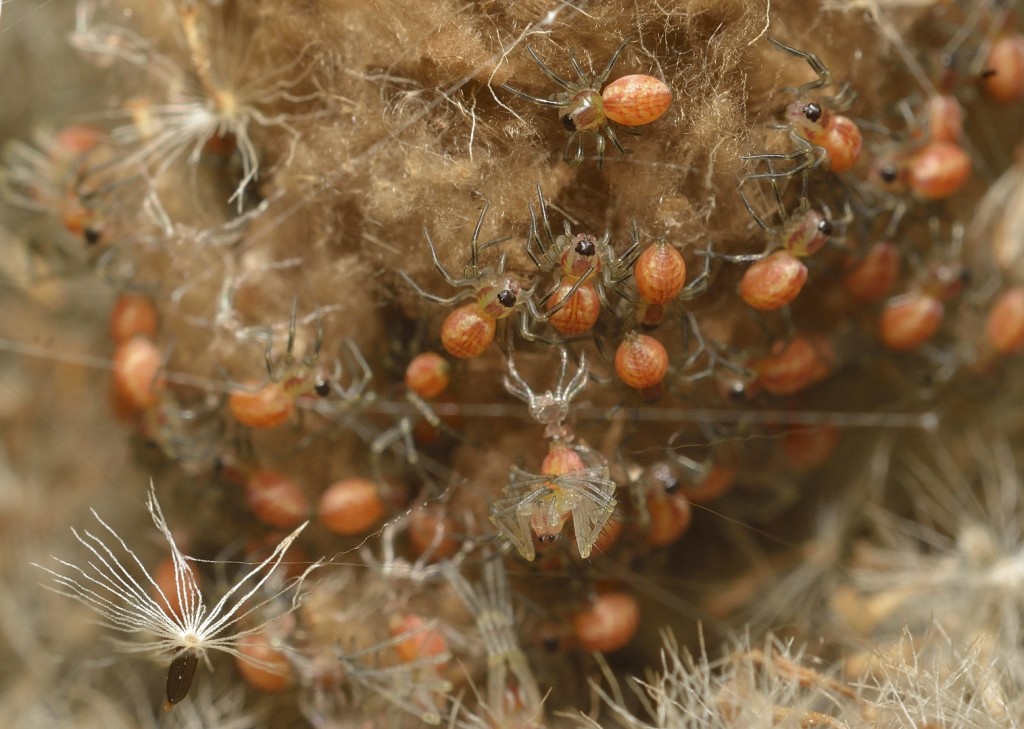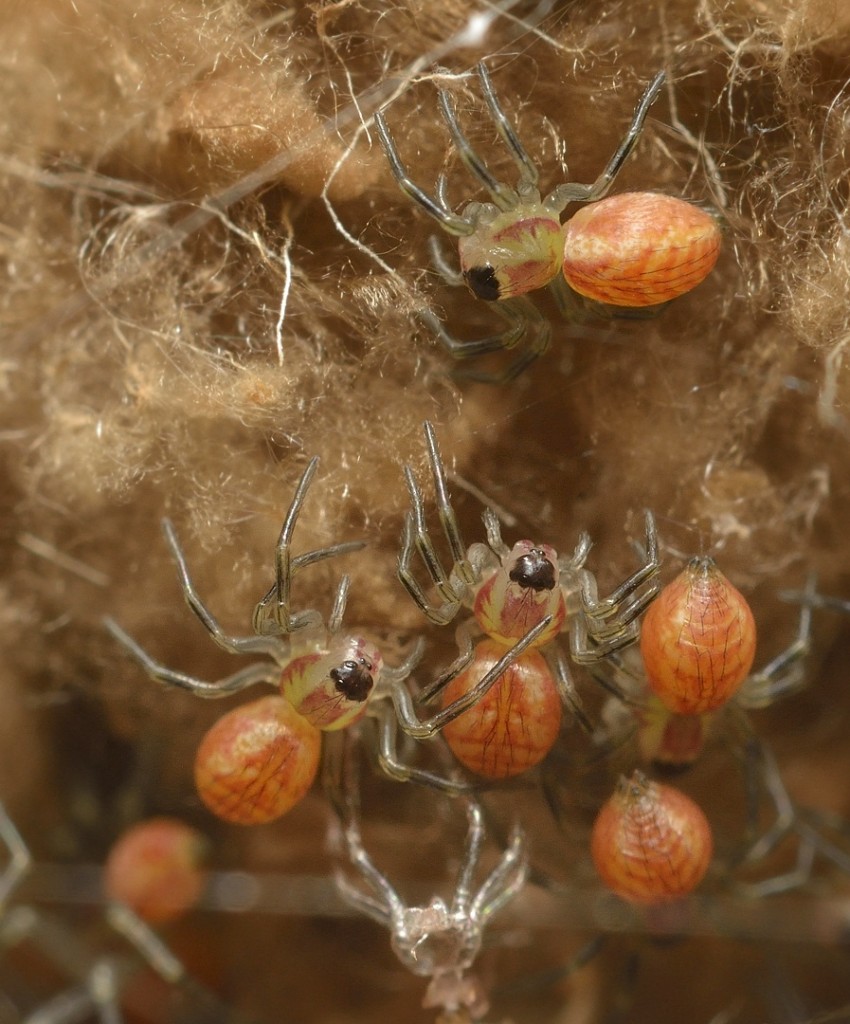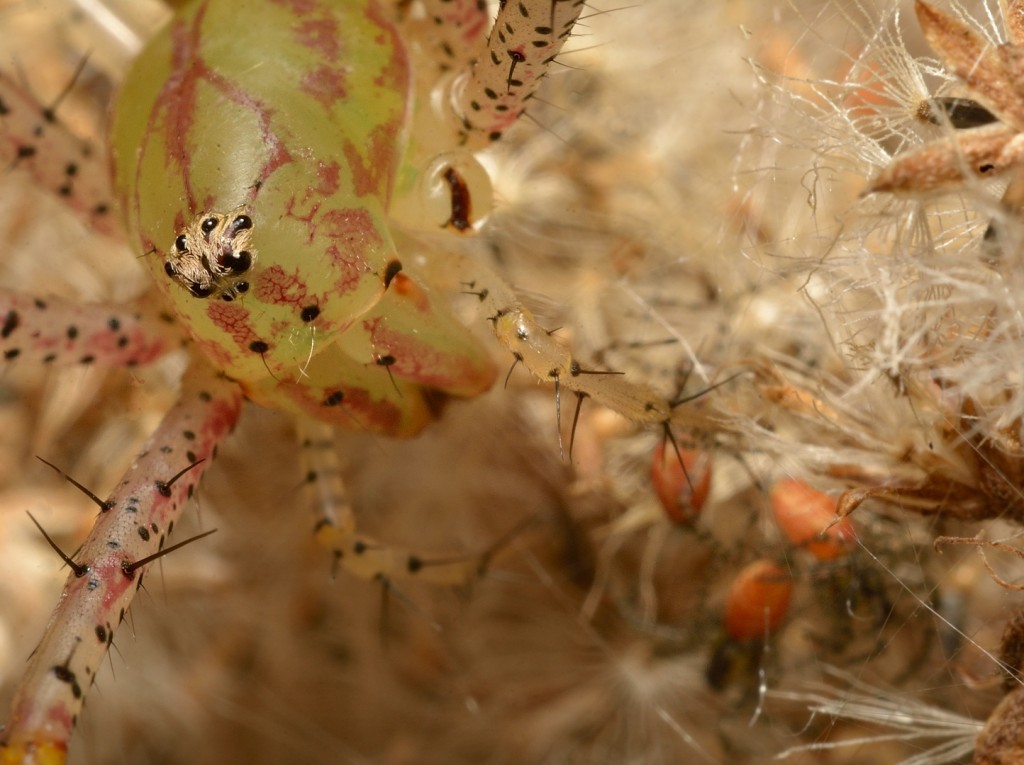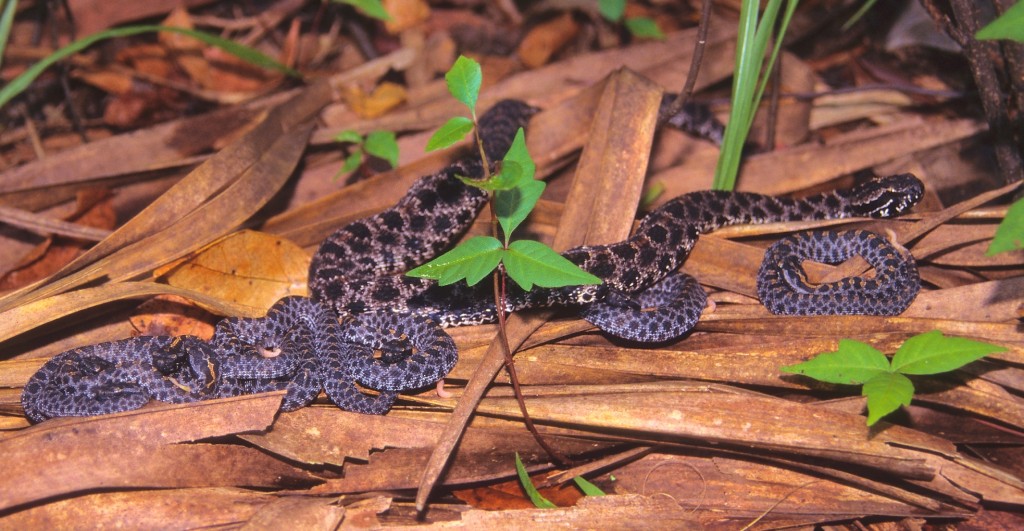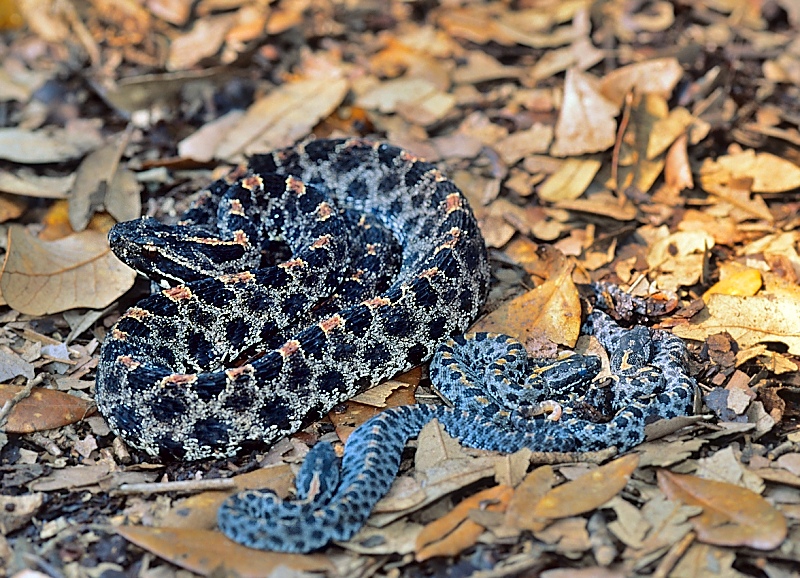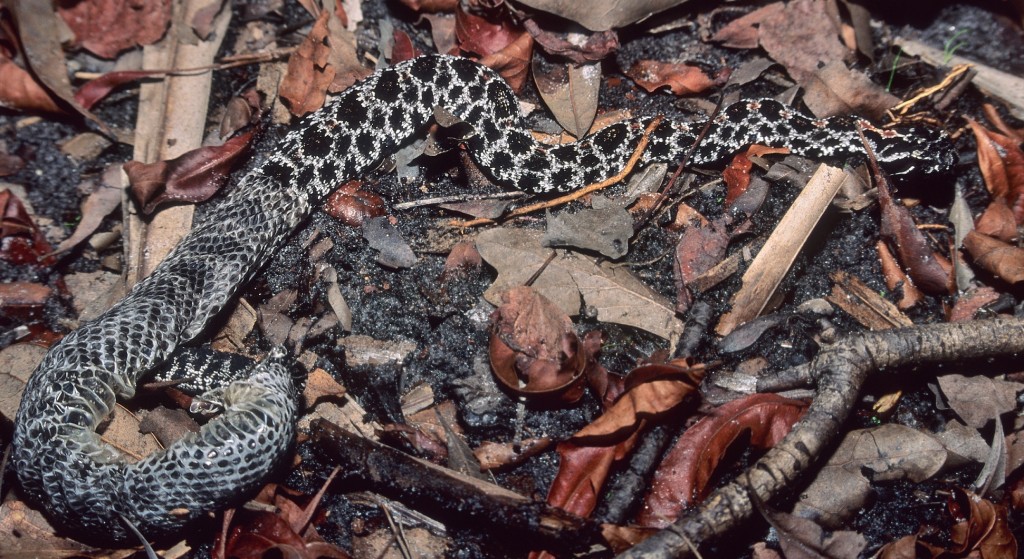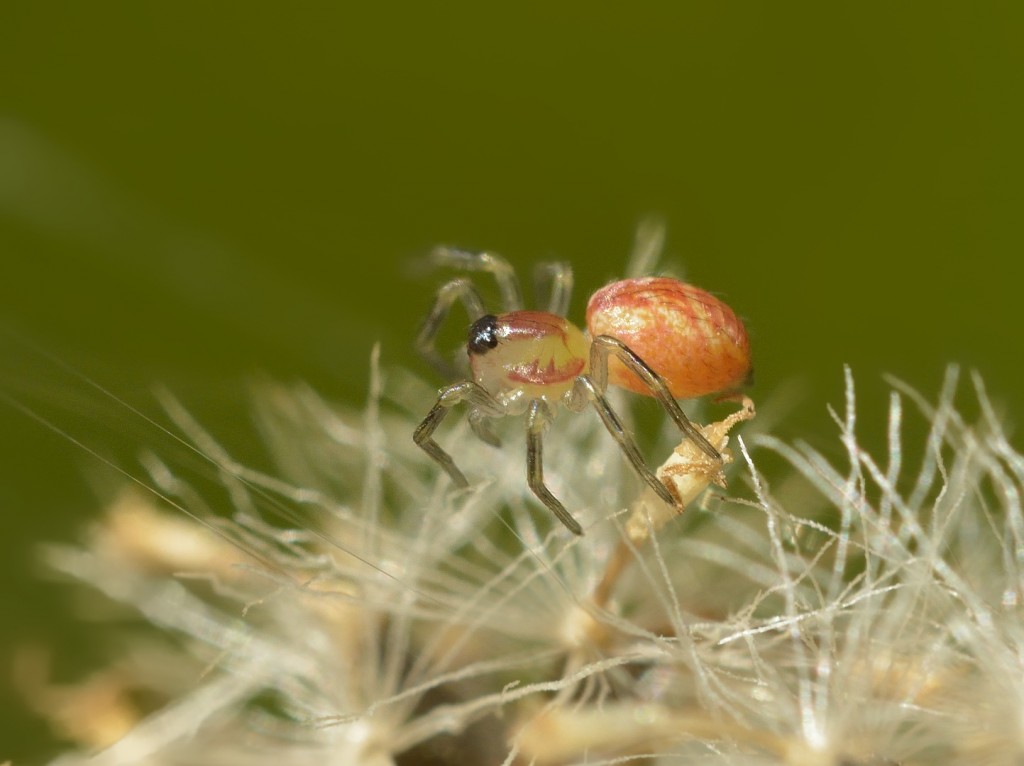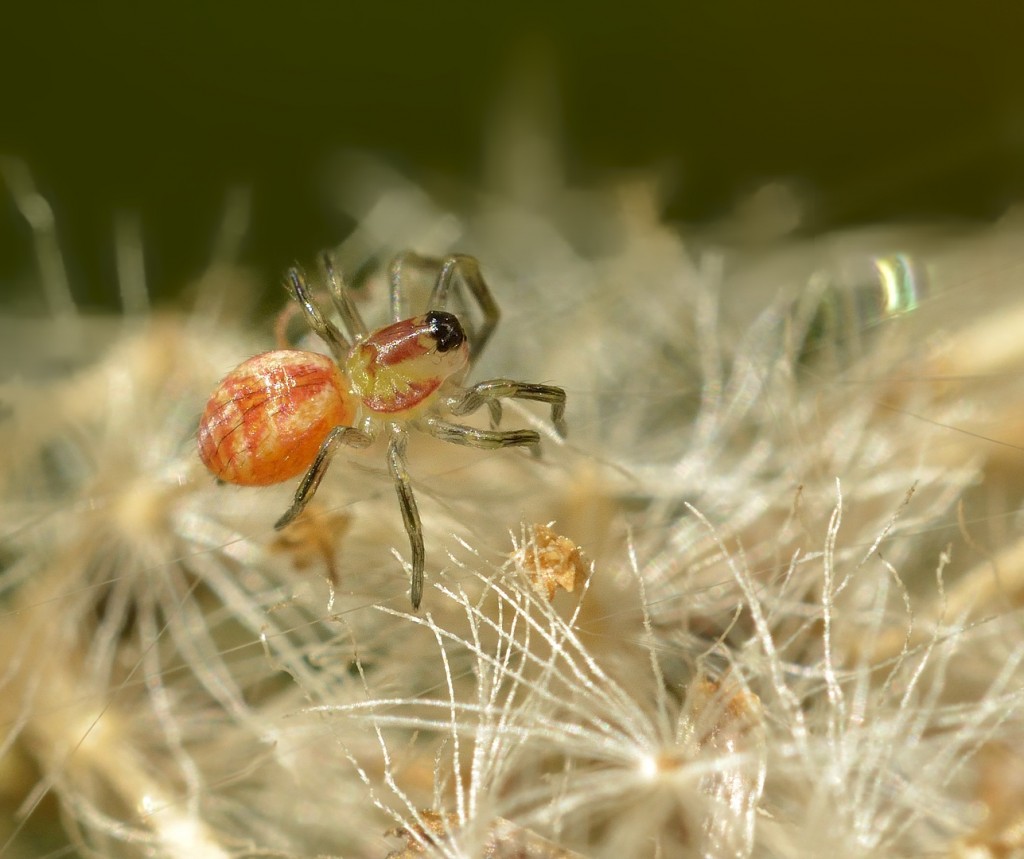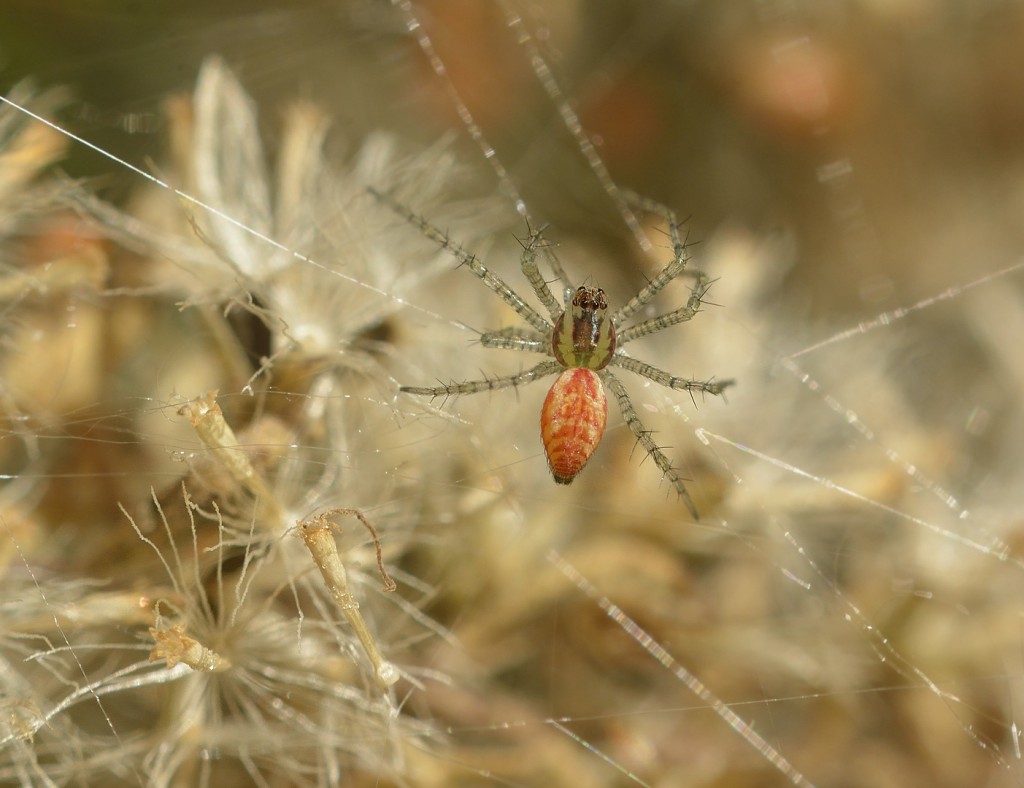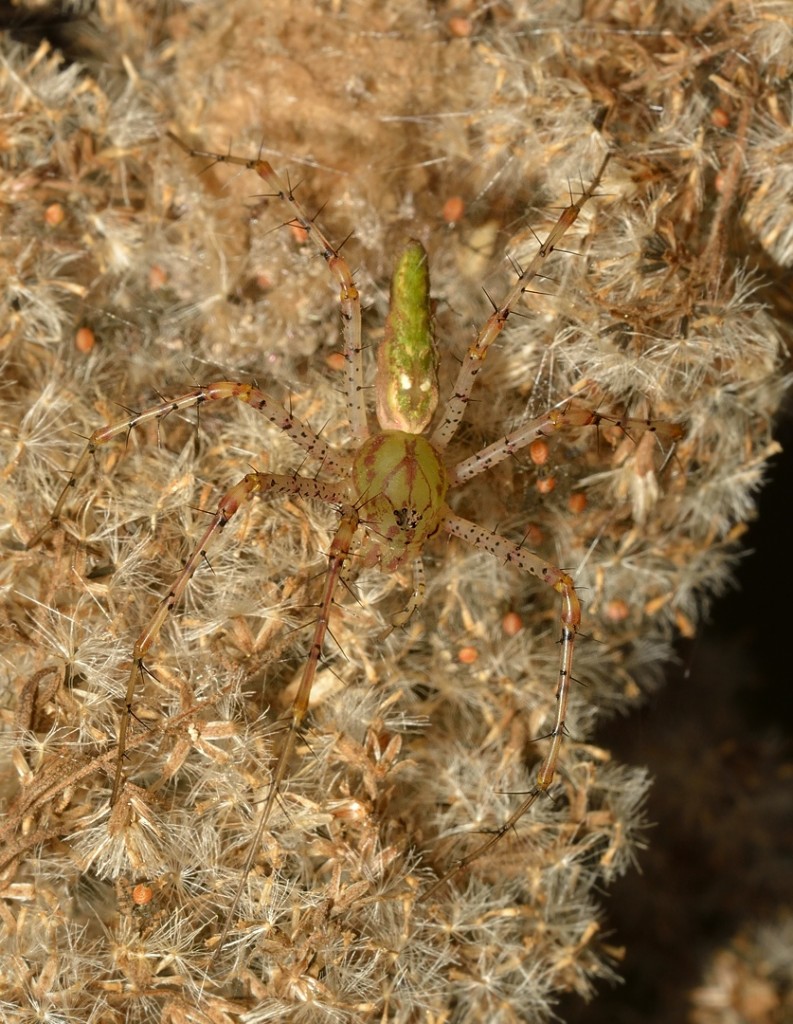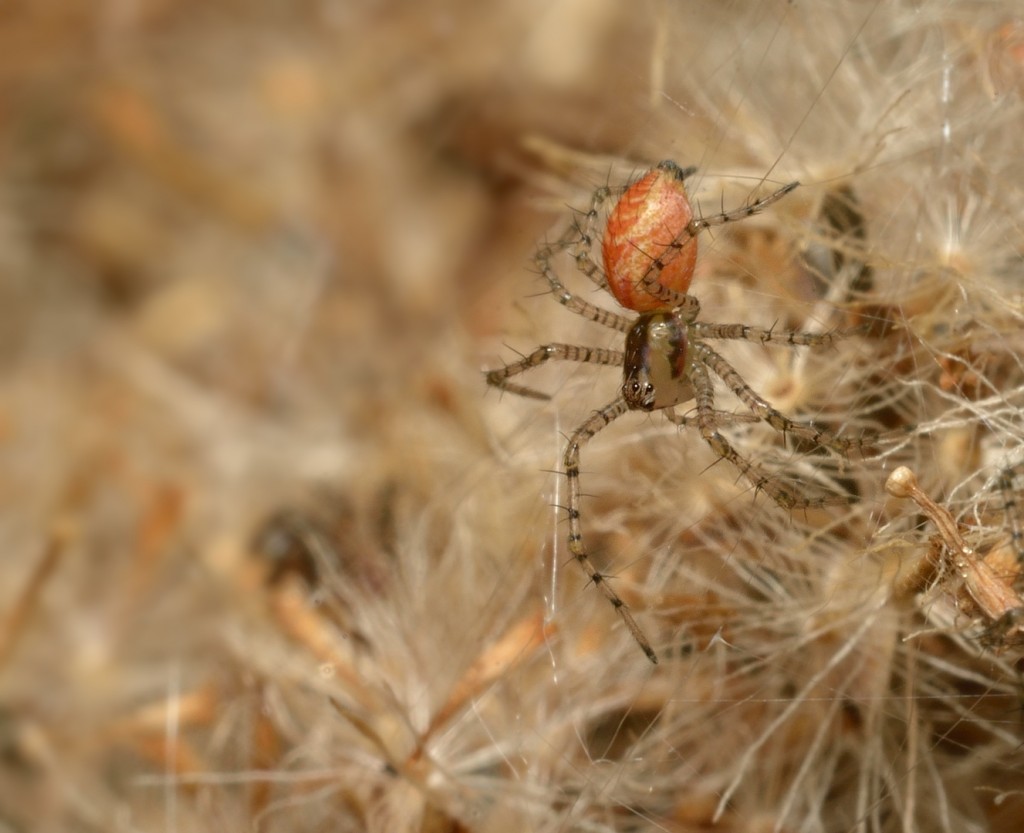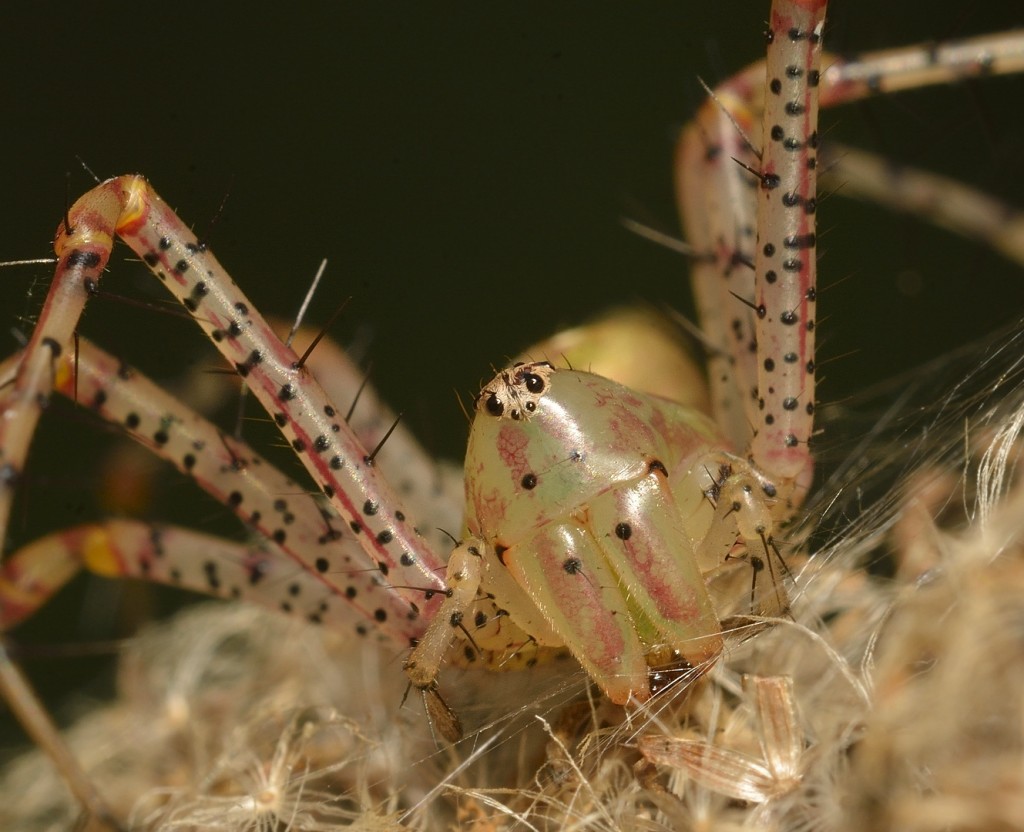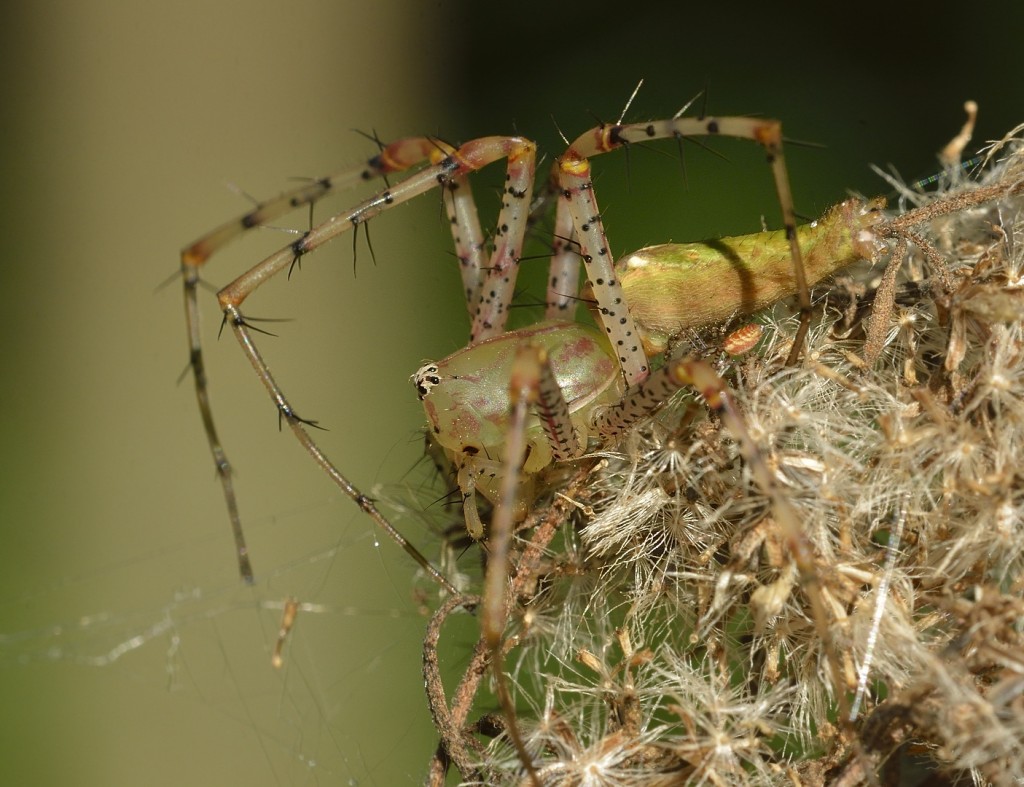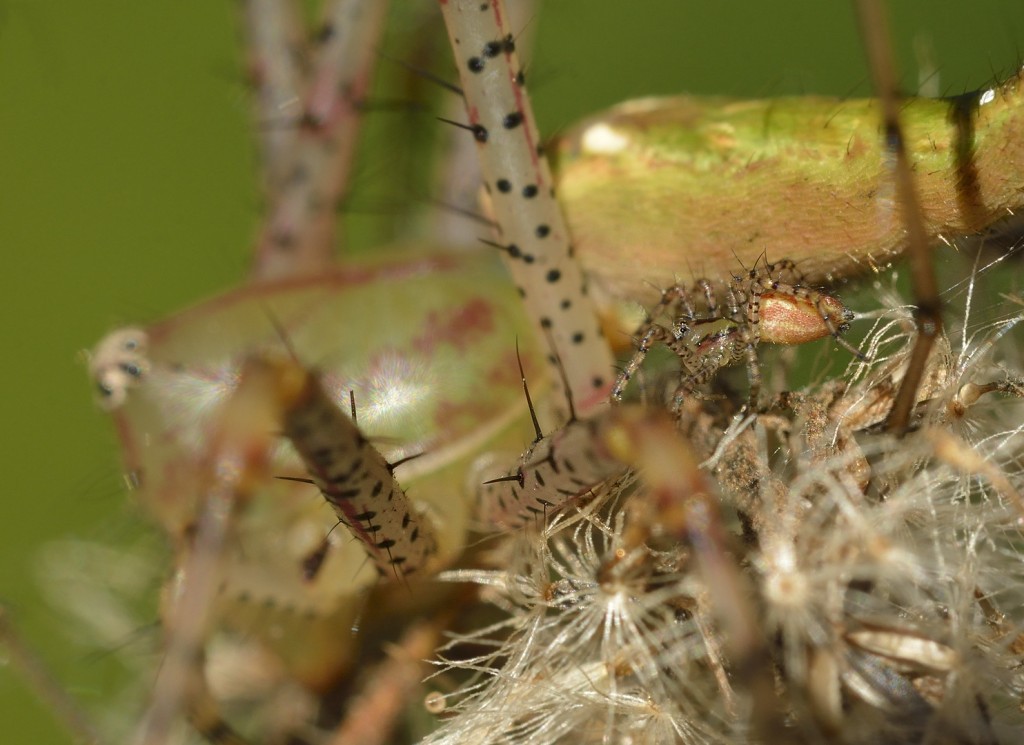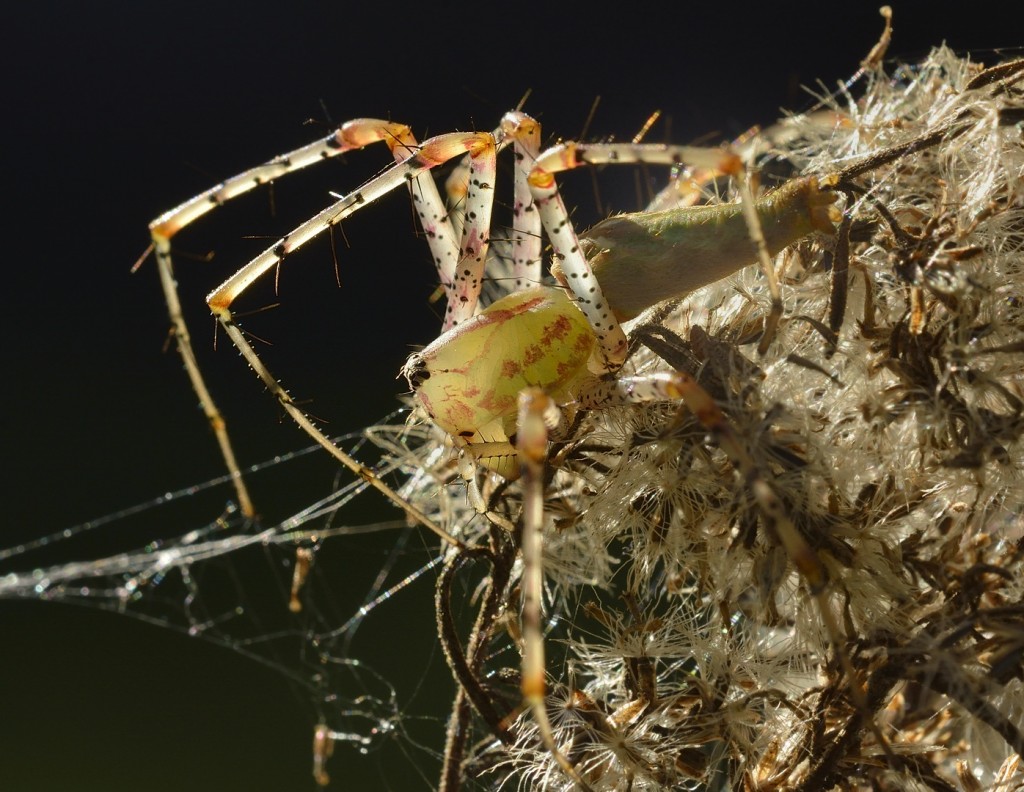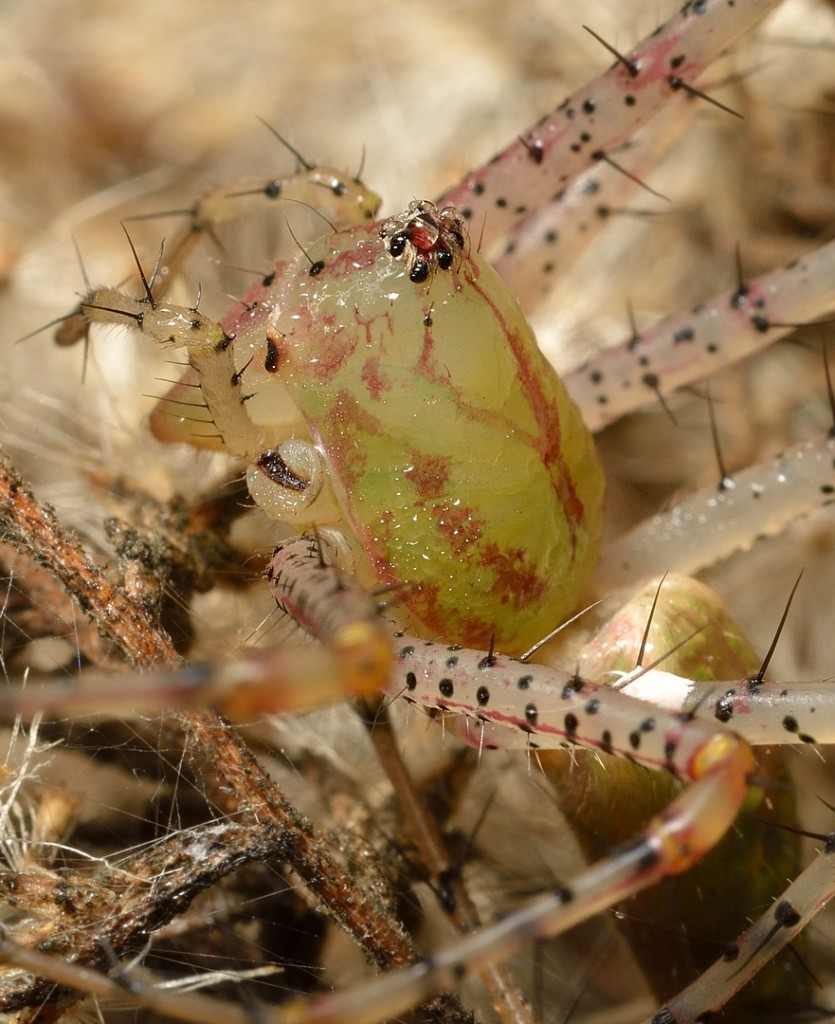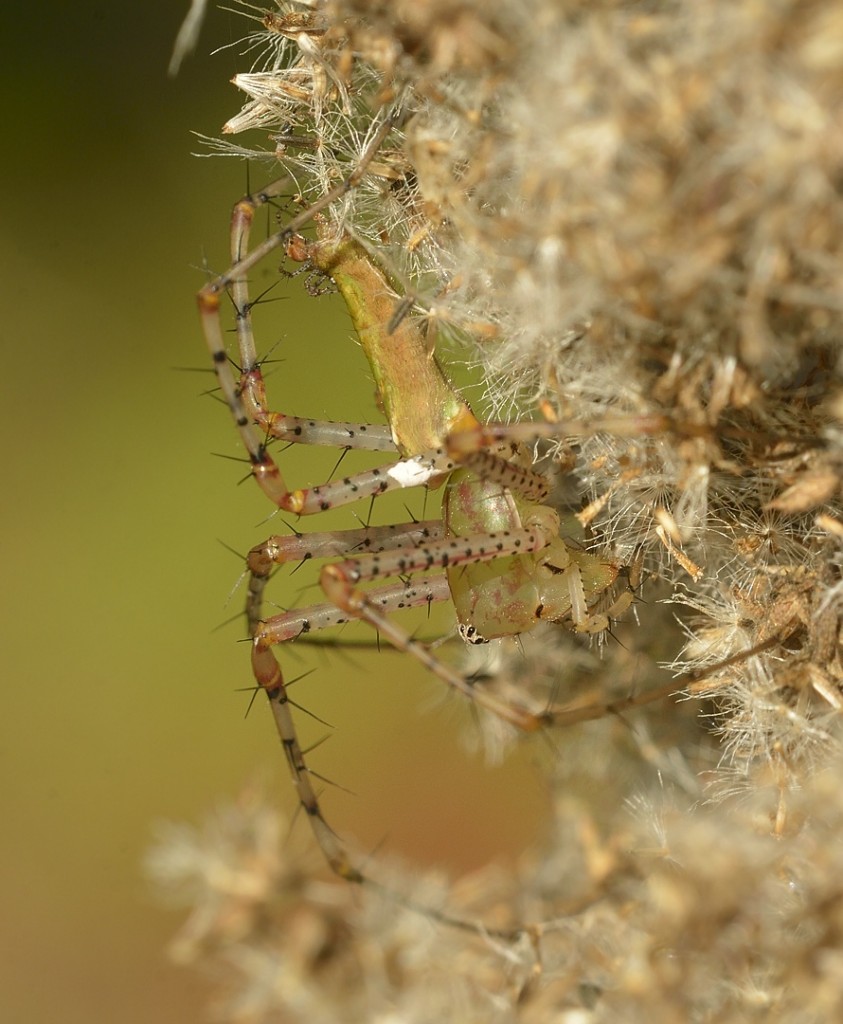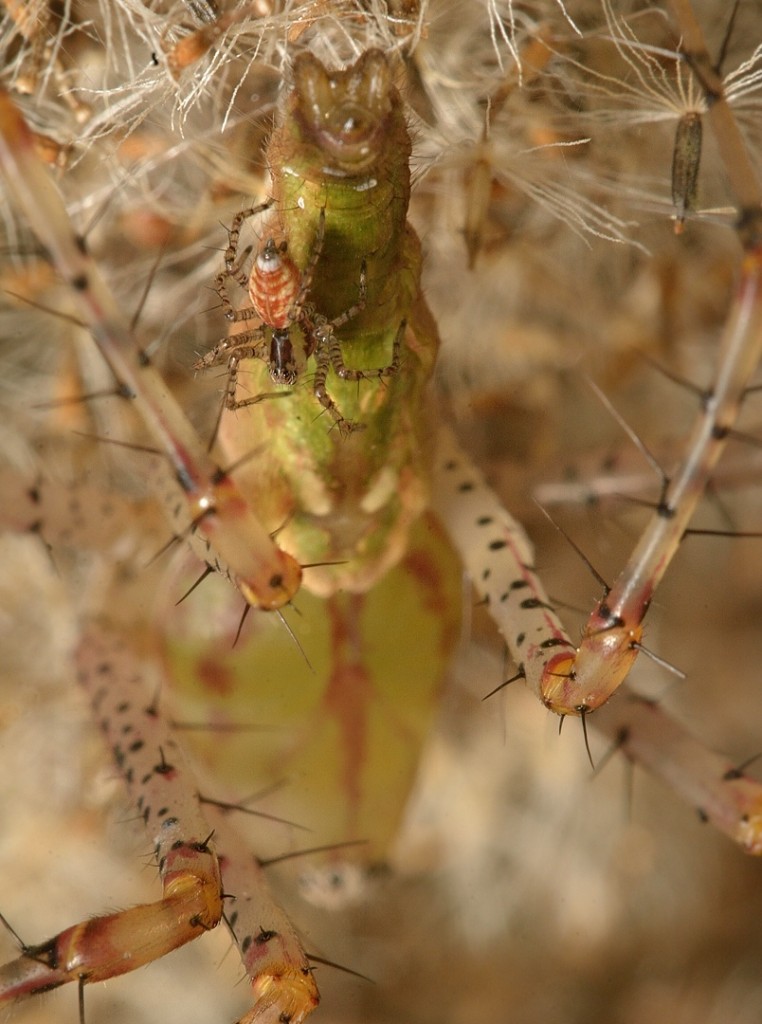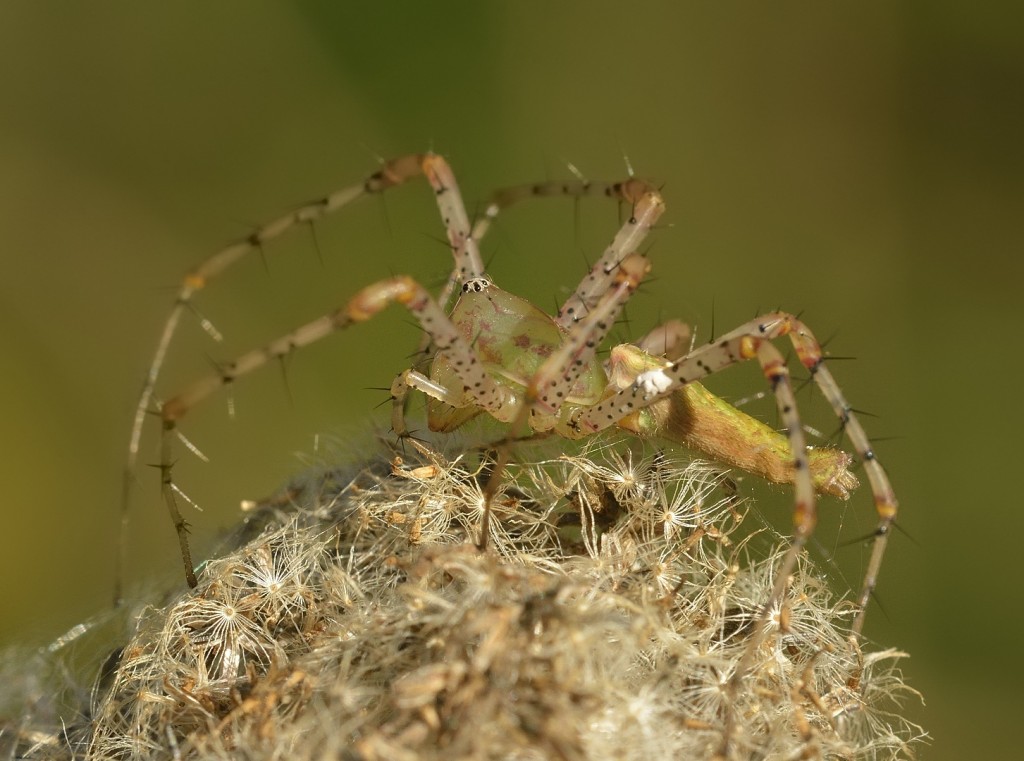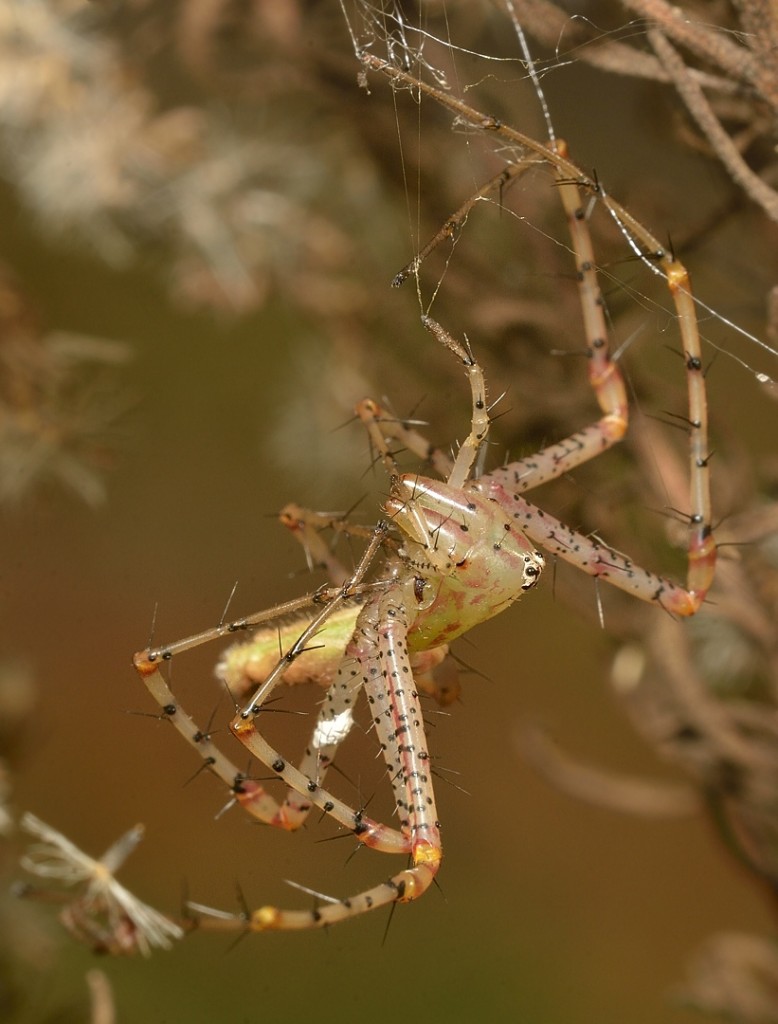December 13, 2014
The great artist Haddaway asked “What is love?”; neither the Butabi brothers nor I have come up with a satisfactory answer to that question, but if love is judged by actions, then it is much more widespread among animals than is commonly thought .
I hate the term “cold-blooded” as a descriptor of the thermoregulatory syndrome shown by the majority of animals on the planet, but as a literary device it is quite useful. Cold-blooded as a trope hints at an emotionless, detached demeanor, something that seems a world away from the values associated with motherhood. Some of my recent and less recent experiences with cold-blooded mothers suggest the opposite.
Last summer I became entranced with the beauty and behaviors of lynx spiders. Peucetia viridans is one of the first spiders I learned to identify when I moved to Florida (thanks, Craig), and I’ve been aware since then that they are common, widely distributed spiders. But until I began looking for them with more conviction recently, I had no idea of their true abundance. As spider expert Jack Koerner discovered independently, their prowess as predators is prodigious. Not only will they tackle a diverse array of prey, many far exceeding their own body mass, they are also ridiculously abundant in some habitats. As I learned more about them, I began to anticipate the appearance of cocoons and the subsequent maternal behaviors of the females. Jack assured me that they would begin appearing in late September-early October, and he was spot on. I saw my first female guarding her cocoon on October 9, in the Riverside Island tract of Ocala National Forest. After that first sighting, I started seeing them frequently, most often in the head-high inflorescences of dogfennel, Eupatorium capillifolium. On November 1, I found a cluster of 4 females guarding cocoons in a patch of dogfennel at Lake George Conservation Area, and by some coincidence one of them came home with me. I placed her with her cocoon and the top of her home plant on an old tripod, put it on my glassed-in patio, and began waiting.
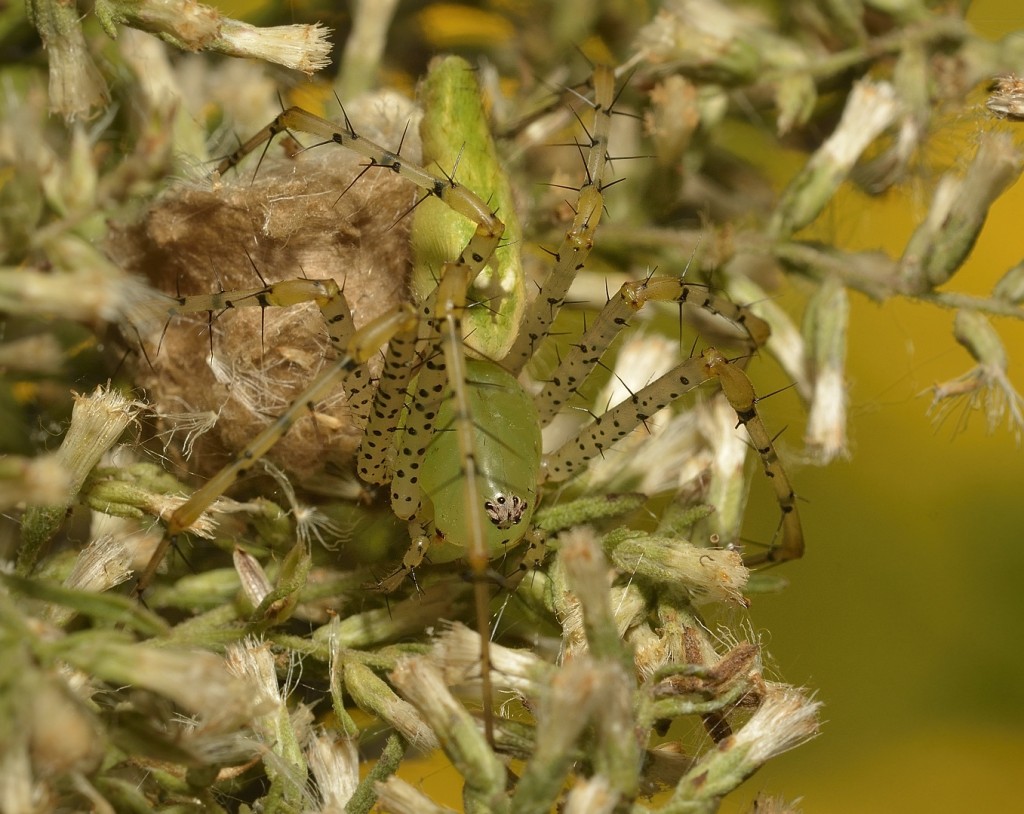
The lynx mother I adopted, on her first day in the patio. Notice that she is missing her left front leg.
At first I wondered if all of the disturbance, combined with the rather profound change in surroundings (a sunlit successional opening in the scrub to a patio in a suburban subdivision) might cause her to abandon her nest. But I trusted in her instincts, and sure enough, she never moved from her perch astride her cocoon.
A couple of weeks into my wait, I began worrying that the thermal environment I had moved her to would be too cool to allow her eggs to develop at a normal rate. The microhabitat where she had built her nest had direct exposure to the sun for at least a few hours a day; that heat boost must speed up embryological processes. I hoped that the benefits of the sheltered patio might compensate in part for her loss of sun – it probably buffered the temperature extremes she would be exposed to in the open. Perhaps the several hours each night she enjoyed temperatures above those of her natural environment would accelerate the development of her babies somewhat. On November 14, while at Lake George Conservation Area, I visited her home patch to check out the progress of the other females from her cluster. They were all still there; none had hatchlings yet. It was while trying to photograph one under field conditions that I felt a little better about taking my female home; the wind was blowing at about 20mph, air temperature was in the 50’s, and it felt damned cold to me. Further, the females atop their dogfennels were being buffeted back and forth violently by the shifting winds, yet somehow managed to hang on despite what must have been a semi-torpid state. If they were bullriders, they would have all earned eights. It took me about 10 minutes to take even a handful of photos, despite trying to brace and stabilize the dogfennel plants as best I could.
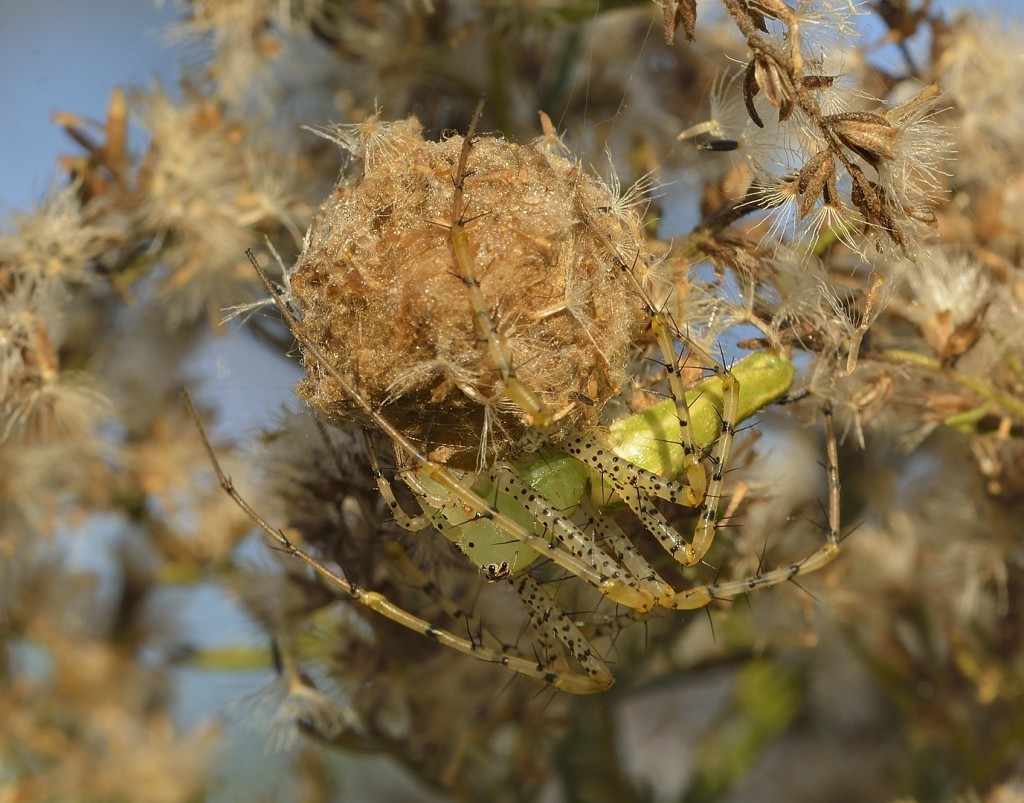
It took me forever to get even one decent image of this mother lynx guarding her cocoon at Lake George Conservation Area. She was being whipped around in every direction by the buffeting winds.
So at home I maintained my vigil, checking every day for the appearance of hatchlings, not even sure exactly what they would look like. Would they be little emerald-green replicas of their mother?
On November 30, John Serrao and I did the Ultimate Ocala Loop © looking for whatever animal, vegetable or mineral coolness we could scrounge up. John had a focal animal for the day; he wanted to find a red widow, and that seemed like a cool goal to me, so we stopped on a couple of occasions in palmetto-studded early scrub so John could scour the scrub for spiders. I was astounded when I saw him walking up the road with a palmetto frond, grinning like a hyena. He’d found his widow. I should have seen that as the grand spider omen it was. When we got back to my house, we found that my lynx babies had hatched overnight or early that morning. Big day for the spiders.
For the next two weeks, I had the awesome privilege of watching a master mother at work. On the day I found her newly-hatched babies, I put momma lynx and her tripod-mounted home plant in my backyard garden, in a spot where they would receive at least several hours of direct sun exposure each day. I didn’t really know how long her maternal devotion would last.
For the first several hours after hatching, her entire brood of 40 or so dapper little spiderlings (mostly orange, not green!) remained within a couple of cm of the cocoon, with mom lurking either directly over them or nearby. Any movement of the dogfennel head or activity near the cocoon would bring her rushing over and posting up in an aggressive stance. I took a bunch of photos, and didn’t realize until I processed the images that some of the spiderlings were already shedding their exoskeletons for the first time.
That’s when I thought of the other cold-blooded mother I’ve had some experience with. Pigmy rattlesnakes. And I began to make comparisons. Pigmy rattlesnake mothers stay with their litter of 2-12 baby rattlesnakes for several days after they give birth to them (most pit vipers give birth to living young rather than laying eggs), which was quite a revelation to me when we were doing pigmy rattlesnake studies back in the 90’s. Not only do they stay near them, they actively defend them against some predators (such as other snakes). Unlike mother lynxes, though, we never saw any sign of aggressive defense by mothers towards big stinking primates. The response of both mother and baby rattlesnakes to the approach of hulking sweaty bipeds was usually to retreat to cover in a fairly leisurely fashion. The mothers were simply choosing the battles they could win; mothers kept in captivity with their young did show an aggressive approach towards a predatory snake (black racer) that was tethered and moved towards the female and her young. (No racers were harmed in the process of provoking these pigmy moms!)
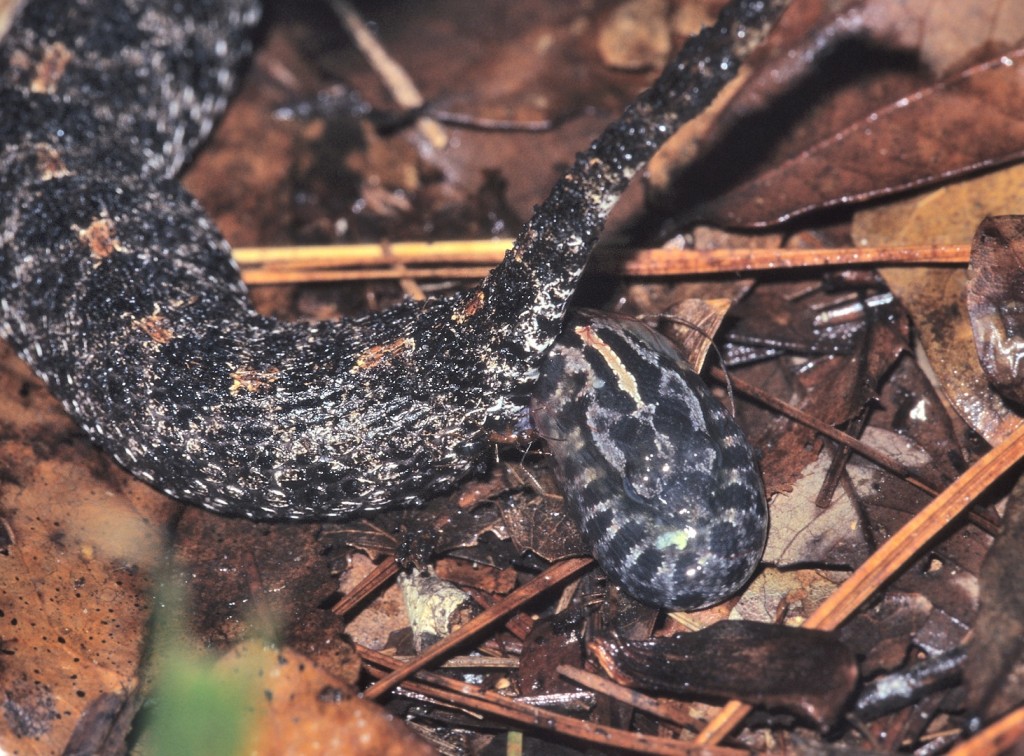
Nearly all pitvipers, and many other snakes, give birth to living young. This is a pigmy rattlesnake birth.
Mother pigmy rattlesnakes maintain their maternal attendance until their babies have shed their natal skin; as soon as they do that, 1-4 days after birth, the kids disperse in all directions, and their association with their mother is over forever. Oh, I suppose they might bump into each other at some point during their subsequent lives, but we found no evidence suggesting the kids periodically return to visit their mother. Or even call.
So based on my experience with pigmy motherhood, I thought that perhaps lynx mothers were similar; soon after they hatched and shed, the babies would disperse, and mom would do whatever mother lynxes with empty-nest syndrome do. Which is mostly die. Lynx spiders, unlike pigmy rattlesnakes, reproduce only once, and then die.
Around noon the day after the lynxes hatched, I checked out the dogfennel briefly, and didn’t see mom or any spiderlings near the cocoon. I concluded, prematurely as it turns out, that the babies had all ballooned away and the mother had departed. Many young spiderlings, when ready to disperse from their birth site, climb to the top of a plant when there is a breeze blowing, stick their butts up in the wind and begin releasing silk. When enough silk is out, they release their grip and drift away on their silken balloon. I was pretty pleased at the prospect that all those spiderlings were now safely ensconced in little lynxy hidey-holes scattered around my garden, and that I might see some of them the following spring and follow their growth and maturation.
The next day I decided to do a more thorough search for a lingering baby or two and was surprised and delighted to find the female back atop the plant. As I looked carefully around the dogfennel inflorescence, I found 10-15 babies scattered around the many nooks and crannies of the dogfennel head, now covered with seeds and their pappuses (pappi?). Looking very much like little spiders. Coincidence, Harry Tiebout? It didn’t take long for mom to key in on whatever part of the plant I was focusing on and come rushing over. The next day she was surrounded by 15-20 of her babies, clustered loosely around her again.
And now here it is, two weeks after birth, and mom is still hanging on. She’s missing a leg, has a patch of white fungus growing on one of her legs (immune system shutting down?), and is moving at an arthritic pace even at mid-day temperatures. Every morning for the last several days I’ve gone out to check on her, expecting to find her dead. Some mornings it’s not easy to tell at first. I can gently prod her and move her legs, and in her early-morning torpid state, it’s hard to tell if there’s any voluntary movement at all. But by mid-morning, after a nice spot of sun, she’s still endeavoring to persevere. Perhaps I should craft her a tiny stove-pipe hat and declare her civilized.
Yesterday, I thoroughly inspected the plant with a visor magnifier, and found only one baby remaining. On mom. For whatever it’s worth, a more devoted and persistent mother than the more “advanced” pigmy rattlesnake. The baby lynx stayed on his mother’s emaciated abdomen for several minutes while I photographed them, and then rappelled on a silken dragline to a seed cluster below. Mom moved achingly slowly to the top of the plant to bask. Would this be her last sunset?
Just 15 minutes ago, I could find no baby lynxes other than one tiny mummified little corpse. But mom is still there.
Does a mother pigmy rattlesnake or lynx spider love her babies?
What is love?
Postscript, December 21:
She was tougher than I gave her credit for. She was dead this morning, over a week after the last of her offspring had dispersed.
